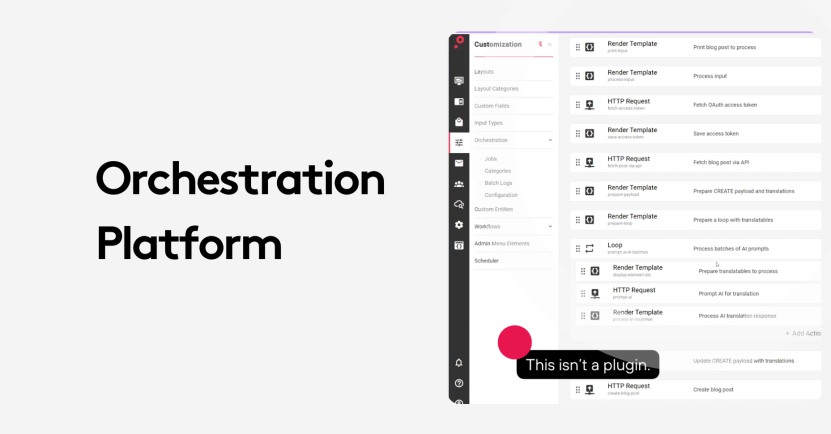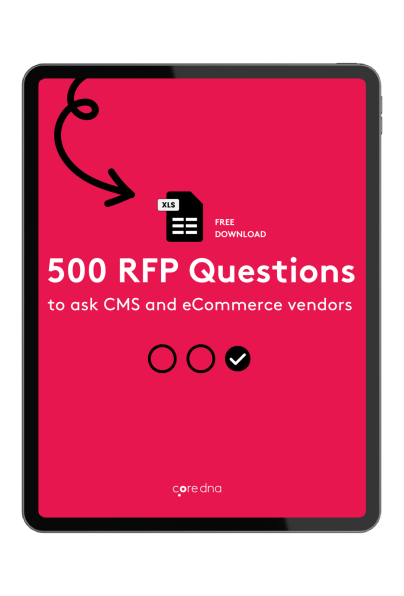Beyond Automation: Introducing Core dna’s Orchestration Platform

Most businesses don’t struggle because they lack tools, they struggle because those tools don’t work well together.
Every department, marketing, operations, IT, sales, ends up cobbling together software, plugins, APIs, and spreadsheets just to get simple things done. The result? A patchwork of systems and manual workarounds that slow teams down, inflate costs, and limit innovation.
Orchestration changes that.
Key takeaways
- Core dna’s orchestration platform lets you coordinate all your tools, tasks, and workflows from one central place.
- Integrations like ERP and CRM connections are handled with visual logic, not custom development.
- You can launch AI agents for SEO, auto-translation, and real-time personalization, all inside the platform.
- There’s no need for plugins or external tools because everything runs natively within your orchestration platform.
- This approach helps businesses move faster, reduce risk, and scale without adding more complexity.
On this page:
What is an Orchestration Platform?
When we talk about an Orchestration platform, we don't mean just automation. To be able to orchestrate a digital presence is we need to coordinate every tool, task, and logic flow inside your digital ecosystem.
With orchestration, you define how your business operates digitally: what happens when, who triggers it, and how it all connects. It’s not just about automating repetitive work. It’s about designing the entire flow of your operations so everything moves with precision.
At Core dna, we’ve built orchestration into the core of our platform so that every piece of your stack, content, commerce, CRM, LMS, and AI, can speak the same language.
It means that integration with your ERP, CRM, or third-party service becomes second nature. It also means if your marketing team dreams up something they’re spending hours doing manually, they can build a helper or AI agent to solve it, no dev team required.
For example, every time we publish a new blog at Core dna, it’s automatically pushed to a section in our Gmail signatures across the company. No plugins. No Chrome extensions. Just orchestration, fully native to our platform.
That’s our mindset: Core dna isn’t just a CMS or an eCommerce platform. It’s a digital operating system, designed to power your business, whatever that looks like.
The Components Core dna's Orchestration Platform
Inside Core dna, orchestration is built around a set of modular, composable tools. You choose what category of orchestration you need, marketing, data sync, user flows, internal operations, and build a logic-driven flow that mirrors your process.
Over time, you can catalog and refine your orchestrations into a library that supports your teams and evolves with your business. These are the different orchestration categories you can choose from:
- Automations: Configure reusable, event-driven workflows that operate across modules, content types, and services. Think: automatically updating product feeds when inventory changes, or triggering a workflow when a user completes a form.
- Notifications: Send alerts via email, SMS, Slack, or internal channels as part of flow-based actions. For example, alert the fulfillment team via Slack when a high-value order is placed.
- Apps: Launch internal or external apps, including AI agents, as part of orchestrated flows with dynamic logic and inputs. For instance, an internal translation app that localizes new product pages instantly.
- Microservices: Deploy synchronous or asynchronous business logic as custom services using your preferred language or framework. A good use case: pricing calculators or regional inventory services that plug directly into the platform.
- Marketing: Trigger omnichannel campaigns, personalize content delivery, and segment users across touchpoints. From welcome email journeys to location-specific offers, all can be managed from inside Core dna.
- Integration: Connect to third-party platforms like Salesforce, SAP, or Mailchimp with bi-directional, secure data sync. No middleware required.
- Helper Functions: Inject utility logic such as formatting, lookups, and conditional evaluations into any orchestration. Example: convert date formats before sending data to an ERP.
- Webhooks: Listen for incoming external events and trigger workflows in real time across internal systems. For example, when a new partner signs up via a third-party form, start a full onboarding sequence.
These aren’t plugins. They’re composable building blocks inside your own platform.

Why is Orchestration the Future of Digital Platforms
Orchestration isn’t a nice-to-have feature, it’s the new baseline for digital agility.
In 2025, connecting systems shouldn’t be a project. It should be a given. Integrating your ERP, CRM, PIM, or support platform shouldn’t require weeks of dev time, vendor calls, or custom code. With Core dna, it’s drag, drop, done.
Take OAuth authentication as an example. What once took a backend engineer hours of custom scripting, creating secure handshakes, generating tokens, handling callbacks, is now something any team can build in minutes using visual orchestration blocks. It’s secure, reusable, and managed entirely within your platform.
But this capability isn’t limited to developers. That’s the breakthrough.
With orchestration built into Core dna:
- Marketing can launch and iterate campaigns without engineering tickets. Need to trigger a retargeting sequence when a lead downloads a whitepaper? Create it visually. Want to sync segmented audiences across platforms? Build the logic once and reuse it anywhere.
- Content teams can create dynamic distribution rules, like updating every employee’s Gmail signature with the latest blog post, instantly. The content lives in Core dna, syncs automatically, and never touches a Chrome extension or third-party plugin.
- Operations teams can design internal tools that reflect how they actually work, no vendor limitations, no SaaS sprawl. From form logic to partner onboarding workflows, everything lives in one place and evolves with the business.
All of this happens inside Core dna, not stitched together with, third-party platforms, or brittle workarounds.
This is orchestration in action:
- A platform that adapts to your workflows, not the other way around
- Logic that belongs to your business, not hardcoded into someone else’s roadmap
- Agents, automations, and micro-apps that respond in real time, with no maintenance overhead
We didn’t set out to build another CMS or eCommerce engine.
We’re building the operating system for your digital business, one that gives every team the power to create, adapt, and grow without friction.
Because the next generation of platforms isn’t defined by features. It’s defined by how well it lets you orchestrate your own way forward.
Example of Orchestration in action
Orchestration isn’t just theory, it’s powering real, everyday results inside Core dna. Here are just a few ways customers (and our own teams) are using it to transform how they work:
An SEO Agent That Writes Itself
Every time a new product is published, an AI-powered agent generates metadata and alt text based on the product’s title, category, and description. It pulls from your schema, follows your tone of voice, and applies SEO best practices automatically. No more repetitive manual entry or missed optimization opportunities.
An Auto-Translation Agent That Rebuilds Pages Instantly
Global expansion used to require entire dev sprints. Now, when a marketer publishes a landing page in English, an orchestration flow triggers a multilingual agent that clones the layout, translates the content, and localizes visuals—ready for French, Spanish, or Japanese audiences in minutes.
Zero-Data Personalization That Respects Privacy
A personalization engine powered by real-time behavior—not cookies. It adapts messaging, product recommendations, and content layout on the fly based on what users do, not who they are. That means high engagement and conversion rates without third-party tracking or login walls.
OAuth Authentication Without the Overhead
Setting up secure OAuth flows between internal systems or partners used to mean dev tickets, weeks of backend work, and constant testing. Now, Core dna users can build this in minutes: visual blocks handle the entire handshake, token exchange, and callback structure, securely, with no custom code. Whether you’re authenticating a reseller login or connecting an external app, it just works.
Internal Apps That Power the Business
Core dna customers build lightweight internal apps to manage tasks like partner onboarding, training certification workflows, and inventory updates across regional warehouses. These apps run inside the orchestration engine, update content in real time, and integrate with existing systems like ERPs or CRMs, no middleware needed.
The Business Impact of an Orchestration Platform
What happens when you move from fragmented tools to full orchestration? You stop duct-taping your digital strategy together, and start moving with clarity and speed.
- Fewer Tools, More Speed
No more jumping between five systems to launch a single campaign. Everything runs from one unified platform. Marketers move faster, IT spends less time troubleshooting, and your teams are free to focus on strategy, not system workarounds. - Lower Risk
Orchestration lives inside Core dna, so your data doesn’t pass through risky third-party connectors. Every workflow is logged, every action is auditable, and compliance is baked into the platform—perfect for teams that need to move fast and stay secure. - Faster Scale, Lower Cost
Whether you’re launching in a new region, onboarding a new partner type, or personalizing a new journey, you don’t need new platforms or new headcount. Just clone, adapt, and deploy. The result? More output, less overhead, and a shorter path to growth.
Orchestration is not a feature. It’s a foundation. For businesses that want to move fast, stay in control, and create digital experiences that are as unique as they are, it’s the only path forward.
With Core dna, you don’t have to wait for a vendor to build the next tool. You can build your own, today.





